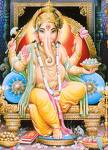Ganesha:
 Ganesha, Gajanana, Vinayaka, eka danti are some of the names he is known as. In the shiva purana it is said that Goddess parvati created ganesha out of the dirt of her body while bathing and assigned the task of guarding until she finishes her bath. Meanwhile lord shiva returned and was furious as he saw a stranger boy would not let him enter. In anger he cut off the boys head. Now parvati was grief struck and pleaded to bring back her son’s life. Thus shiva ordered his men to bring the head of a sleeping being who faced the north. As such they could find only an elephants head. Shiva restored the boys life and declared him as Ganapati (leader of his troops or ganas). This elephant headed god rides on a mouse. He is said to be a god of Wisdom and success and worshiped as one who removes obstacles of his devotees.
Ganesha, Gajanana, Vinayaka, eka danti are some of the names he is known as. In the shiva purana it is said that Goddess parvati created ganesha out of the dirt of her body while bathing and assigned the task of guarding until she finishes her bath. Meanwhile lord shiva returned and was furious as he saw a stranger boy would not let him enter. In anger he cut off the boys head. Now parvati was grief struck and pleaded to bring back her son’s life. Thus shiva ordered his men to bring the head of a sleeping being who faced the north. As such they could find only an elephants head. Shiva restored the boys life and declared him as Ganapati (leader of his troops or ganas). This elephant headed god rides on a mouse. He is said to be a god of Wisdom and success and worshiped as one who removes obstacles of his devotees.
With reference to dance, the Abhinayadarpanam states
urogatabhyayam hastabhyam kapittyo vignaratakaraha

Ganesha is shown by holding kapitta hasta in the right hand, while the same hasta is held in the left hand, but facing downwards. Both the hands are held at the naval level.

niceeeeeeeeeee
i like it
My mother is a dance teacher, and I have learned since I was six years old. I came across your videos a few weeks back. First, I want to say you’ve done a very thorough and comprehensive job with teaching steps and mudras. However, as I have commented on my own blog, don’t you think part of Bharatantayam’s appeal is that it is such a rich tradition and requires the guru-shishya relationship?
Also I have question ( just because I’m curious as to what trend this may lead to. your’s is not the first online bharatanatyam website I have seen): do you think online teaching of Bharatanatyam may replace real teaching?
Dear Amritha, you are lucky to have a guru at home. I offer my respects to your mother. Onlinebharatanatyam is an effort to propagate this art form, and share this information with all those who do not have such privileges. I have already commented on this at the beginning. With god’s grace and gurus blessings the response right from the beginning has been encouraging. That has kept me going. Best Wishes to You!
CAn you comment on why you think Lord Ganesha is depicted this way? What do those kapithas symbolise? Someone told me they arepresent him holding his angavastra…Do you think so?
The left hand represents the tail of the snake that he ties around the waist and the right hand represents the trunk. There are few more explanations, that may be different.
Namasté, un grand merci pour ce site. Je danse depuis tjrs , et le Bharatanatyam depuis qqls années, mais voila je n’ai plus de professeurs depuis qqls mois, il n’est pas simple ds mon environnement de trouver un professeur sauf au conservatoire , et je n’ai plus l’âge pour être admise, et comme je ne veux pas m’arrêter j’ai fais des recherches sur site, je tiens à vous dire que votre site est un vrai cadeau , tout est si bien expliqué, merci encore et bonne continuation, c’est un beau partage que vs faite. K.J
Dear katy, Thank you for your kind words. I donot understand french, but thanks to google translate. as you have said you donot have teachers around. You can always try out the online one to one classes that I offer. Let me know. Thanks
Thanks for sharing. I have an article talk about Lord Ganesha.
Plese browse my article on http://anacaraka.info/lord-ganesha
Could u please give the meaning of the sloka for ganesha devahasta.. word by word
sorry as that was not a comment as such but this has given me a lot of info
I am so happy to have found your site. I have huge respect for Indian classical dance. The site is so well detailed and informative. It is a great platform for people like me who are interested to learn Bharatanatyam to have a good beginning.
Can you please explain the meaning of Kapitta mudra when we show Lord Ganesha? What do they signify?
Thank you.